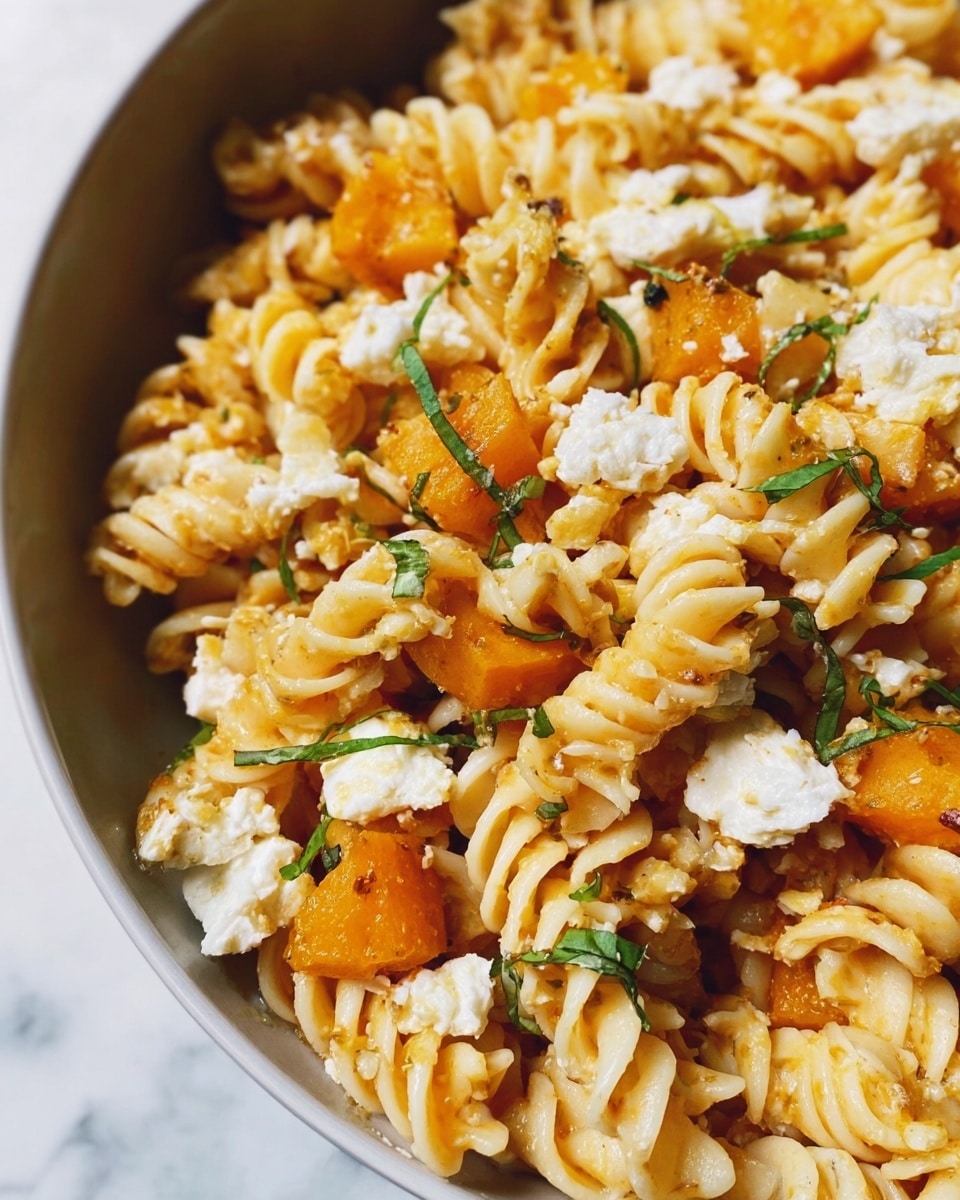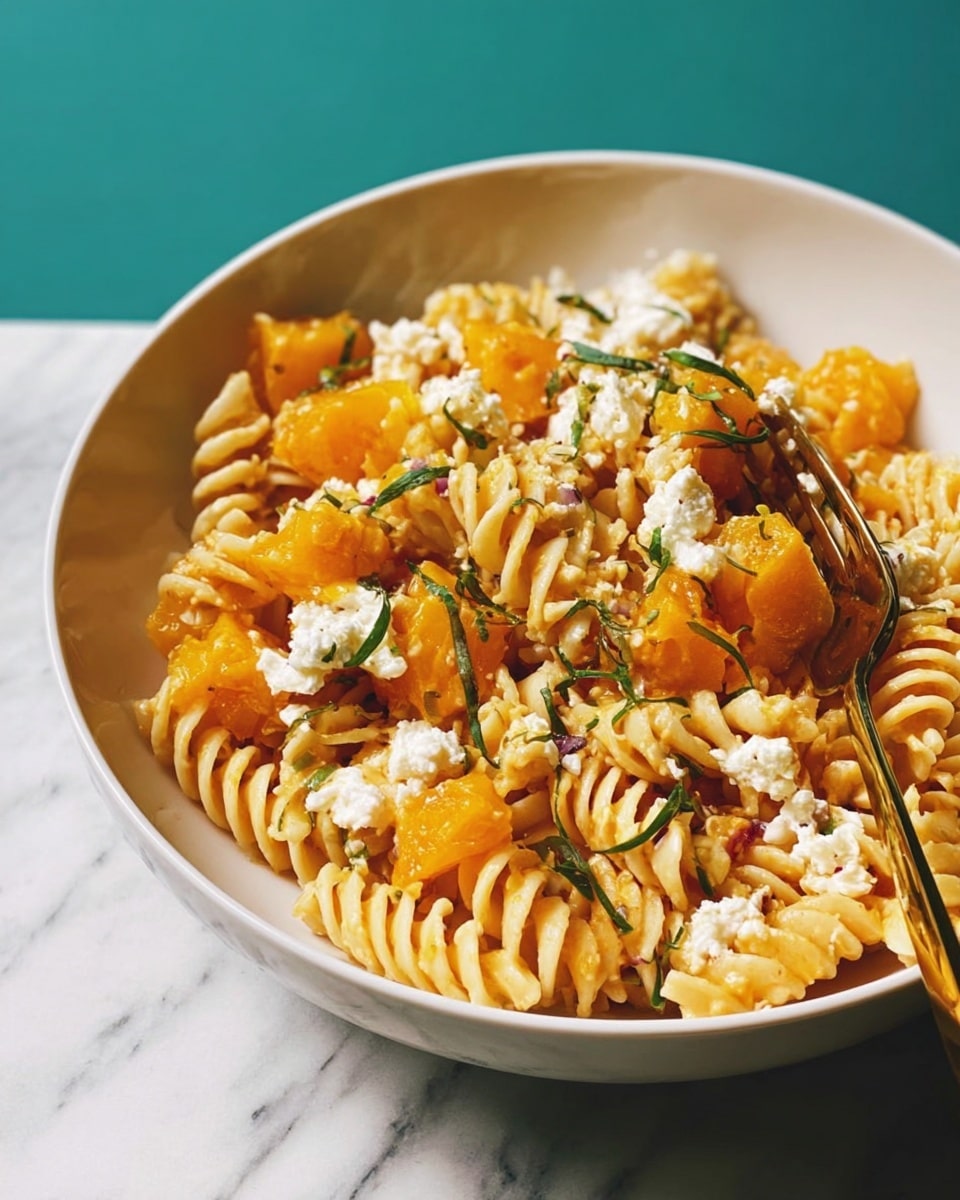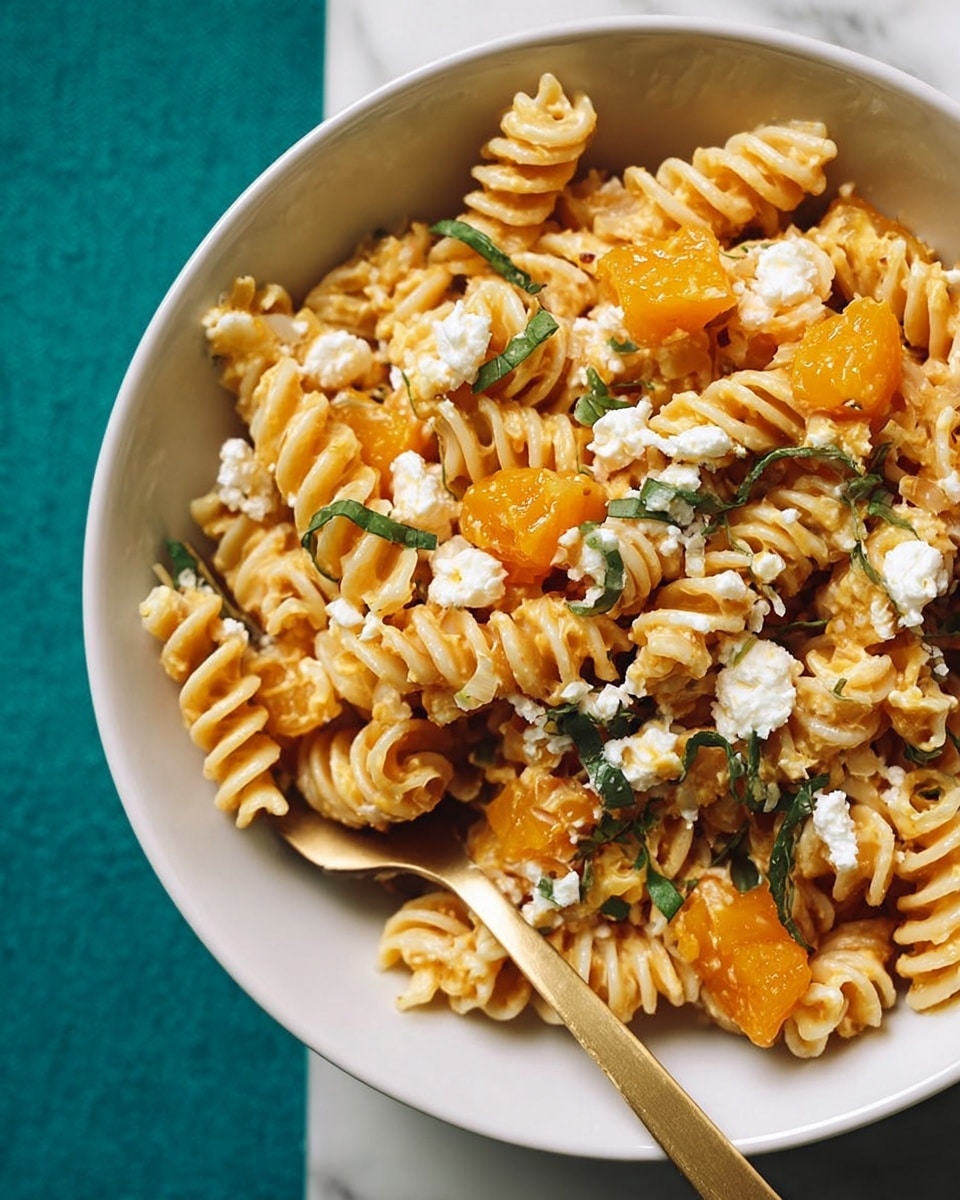I absolutely love how this Baked Feta and Butternut Squash Pasta with Sage and Garlic Recipe comes together with its cozy, buttery-sweet flavor balanced by the sharp tang of feta and fresh sage. It’s that perfect dinner to cozy up with on any night when you want something comforting but with a twist that feels just a little bit special. You’ll find that baking the feta with the squash creates this creamy, melty sauce that feels indulgent without being heavy.
When I first tried this recipe, I was amazed at how simple ingredients like butternut squash, garlic, and sage transform into something so rich and vibrant. This dish works wonderfully for weeknight dinners but also shines when you want to impress friends without spending hours in the kitchen. Trust me, once you make this Baked Feta and Butternut Squash Pasta with Sage and Garlic Recipe you’ll keep coming back to it!
Why You’ll Love This Recipe
- Creamy, Flavorful Sauce: Baking the feta with butternut squash creates a naturally creamy sauce packed with rich flavor.
- Simple Yet Impressive: Uses just a handful of fresh ingredients yet delivers a restaurant-worthy dish you can make at home.
- Perfect Comfort Food: The combination of roasted squash, sage, and garlic is warming and satisfying especially on cooler days.
- Customizable and Easy: You can adjust spice, herbs, or pasta type to your liking, making it a versatile favorite.
Ingredients You’ll Need
Every ingredient in this Baked Feta and Butternut Squash Pasta with Sage and Garlic Recipe plays a vital role in delivering that balance of sweetness, creaminess, and aromatic freshness. Look for a firm butternut squash and a quality block of feta for the best results.
- Butternut Squash: Choose a firm, evenly colored squash for sweetness and a tender roast.
- Olive Oil: Use good quality extra virgin olive oil to enhance the flavors when roasting.
- Kosher Salt: Provides even seasoning and brings out the natural sweetness of the squash.
- Red Pepper Flakes: Optional but adds a lovely subtle heat – I like a pinch for depth.
- Feta Cheese: Look for a block of feta rather than crumbled – it bakes beautifully and melts into a creamy sauce.
- Pasta: Rotini, orzo, or ditalini work wonderfully here; they soak up the sauce perfectly.
- Fresh Sage: Minced sage leaves add a woodsy, herbaceous note that brightens the dish.
- Garlic: Fresh and finely minced for a punch of aromatic flavor.
- Hot Honey: Adds a perfect touch of sweetness with a kick, but regular honey works great if you prefer mild.
- Fresh Cracked Black Pepper: Always finish with pepper to taste for a little extra bite.
Variations
I’m all about making a recipe your own. With this Baked Feta and Butternut Squash Pasta with Sage and Garlic Recipe, you can swap ingredients or add extras depending on your mood or what’s in season. Here are some of my favorite tweaks to keep things fresh.
- Veggie Boost: I sometimes add roasted Brussels sprouts or sautéed spinach – it ups the veggie power and adds gorgeous color.
- Protein Add-in: Grilled chicken or crispy pancetta mixed in turns this into a hearty meal that my family adores.
- Dairy-Free Swap: Use a vegan feta or omit cheese, then add nutritional yeast for a cheesy flavor without dairy.
- Spice it Up: If you love heat, double the red pepper flakes or toss in some chopped fresh chili peppers.
How to Make Baked Feta and Butternut Squash Pasta with Sage and Garlic Recipe
Step 1: Prep and Roast the Butternut Squash and Feta
Start by preheating your oven to 400°F. Toss diced butternut squash with olive oil, kosher salt, and a good crack of black pepper. Spread it out in a roasting dish, then place your block of feta right in the middle. Drizzle the feta with a little more olive oil, sprinkle red pepper flakes if you like, and season the top with cracked pepper. Pop it in the oven and bake for 30 minutes – you’ll want the squash tender but not mushy, and the feta soft and creamy.
Step 2: Brown the Feta for Extra Flavor
After the initial 30 minutes, carefully shift the squash around—just enough to prevent burning on the bottom, but avoid moving the feta block. Then crank the oven up to 450°F and bake everything for another 5 to 10 minutes until the feta has a light golden brown crust. This little trick deepens the flavor and adds a fantastic texture contrast to the creamy cheese inside.
Step 3: Cook the Pasta and Prepare the Sauce
While the feta and squash finish roasting, boil your pasta in well-salted water until just al dente. Reserve about two cups of that starchy pasta water before draining—it’s pure gold for making your sauce silky. Once the feta is done and browned, pull the pan out of the oven and quickly stir in minced garlic, fresh sage, and honey. These ingredients warm gently and meld beautifully in the residual heat. Add your pasta and pour in one cup of reserved pasta water, stirring everything together. If the sauce feels a bit thick, add more pasta water a little at a time until it reaches that creamy, dreamy consistency.
Step 4: Final Seasoning and Serve
Give your pasta a final taste and season with more salt, pepper, or honey as you like. The balance between the savory feta, sweet squash, fragrant sage, and a hint of honey is so delightful—it’s all about finding your favorite sweet-savory note. Serve it warm and revel in every bite.
Pro Tips for Making Baked Feta and Butternut Squash Pasta with Sage and Garlic Recipe
- Choosing the Right Feta: I always pick a firm block of feta instead of pre-crumbled for the perfect melt and oven-baking texture.
- Don’t Skip the Pasta Water: That starchy water is magic for loosening the sauce without watering down the flavor.
- Keep an Eye on the Squash: Stir the roasting squash halfway through baking to prevent burning and ensure even caramelization.
- Add Garlic and Sage at the Right Time: Stir them in after baking so their flavors stay bright and fresh, not overcooked.
How to Serve Baked Feta and Butternut Squash Pasta with Sage and Garlic Recipe

Garnishes
I usually finish this dish with a sprinkle of freshly chopped parsley or basil for a splash of green and fresh aroma. A little extra cracked black pepper and a drizzle of olive oil or more hot honey on top always elevate it. Sometimes I even toast some pine nuts or walnuts for crunch—a nice texture contrast if you’re feeling fancy!
Side Dishes
This pasta pairs beautifully with a simple green salad dressed in lemon vinaigrette to cut through the richness. Roasted vegetables like broccoli or asparagus are also great companions, and if you want some bread, a crusty baguette or garlic bread fits right in for mopping up every last bit of sauce.
Creative Ways to Present
I’ve served this pasta in rustic individual bowls for casual dinners, which feels homey and inviting. For special occasions, I’ve plated it on large serving platters garnished with fresh sage leaves and edible flowers—it really dresses up the table and impresses guests without added fuss.
Make Ahead and Storage
Storing Leftovers
I store leftovers in airtight containers in the fridge, and they keep well for up to 3 days. The pasta may absorb more sauce, so don’t be surprised if it thickens—just loosen it with a splash of water or olive oil when reheating.
Freezing
While I haven’t frozen the whole assembled pasta (feta texture changes), I do freeze roasted butternut squash and baked feta separately. When you thaw and reheat, just toss them with freshly cooked pasta for best texture and flavor.
Reheating
Reheat gently on the stovetop over low heat with a splash of pasta water or olive oil to restore creaminess. Avoid microwave reheating if possible as it can make the feta gritty; stovetop gives better control and texture.
FAQs
-
Can I use other types of squash in the Baked Feta and Butternut Squash Pasta with Sage and Garlic Recipe?
Yes! While butternut squash is the classic choice for its sweetness and texture, you can try kabocha or delicata squash. Just adjust roasting times depending on the firmness to ensure it’s tender and caramelized but not mushy.
-
What pasta types work best for this recipe?
Pasta shapes like rotini, orzo, ditalini, or small tubes are ideal because they hold the sauce well. However, feel free to use any pasta you love – even long noodles like penne or fusilli work if you prefer.
-
How do I make this dish vegan?
Swap the feta for a vegan cheese that melts well or use a tofu-based feta alternative. Adding nutritional yeast helps add cheesy flavor. Also, make sure your pasta is egg-free for a fully vegan dish.
-
Can I prepare parts of this dish in advance?
Absolutely. You can roast the butternut squash and bake the feta a day ahead, then reheat and toss with freshly cooked pasta and garnish right before serving. This helps reduce cooking day effort.
Final Thoughts
This Baked Feta and Butternut Squash Pasta with Sage and Garlic Recipe isn’t just a meal—it’s become a go-to comfort food in my kitchen. It’s incredibly satisfying, easy to make, and full of flavors that feel both fresh and indulgent. I can’t wait for you to try it and discover how such a simple combination can bring so much joy to your dinner table. Trust me, once you’ve made this, it might just become one of your favorite pasta dishes too!
Print
Baked Feta and Butternut Squash Pasta with Sage and Garlic Recipe
- Prep Time: 10 minutes
- Cook Time: 40 minutes
- Total Time: 50 minutes
- Yield: 4 servings
- Category: Dinner, Pasta
- Method: Baking
- Cuisine: American
Description
A deliciously creamy baked feta and butternut squash pasta featuring roasted butternut squash and feta cheese infused with garlic, sage, and a touch of honey, creating a comforting and flavorful dinner that’s simple to prepare and perfect for fall evenings.
Ingredients
Vegetables & Herbs
- 5 cups Butternut Squash (about 1 large butternut squash)
- 10 leaves Fresh Sage, minced
- 3 cloves Garlic, finely minced
Dairy
- 1 (8 oz) block Feta Cheese
Pantry Items
- ½ cup Olive Oil, plus more for drizzling
- 2 hefty pinches Kosher Salt (just shy of ½ tsp)
- 1 hefty pinch Red Pepper Flakes (optional)
- 1 lb Pasta (such as rotini, orzo, or ditalini)
- 1 tablespoon Hot Honey (regular honey is fine too)
- Fresh Cracked Black Pepper, to taste
Instructions
- Preheat Oven: Preheat your oven to 400°F (204°C) to prepare for roasting the squash and baking the feta.
- Prepare Squash and Feta: Toss the butternut squash cubes with olive oil, 2 hefty pinches of kosher salt, and fresh cracked black pepper. Place the squash evenly in a baking dish and position the block of feta in the center. Drizzle the feta with a little olive oil, sprinkle red pepper flakes if using, and add more fresh cracked black pepper.
- First Bake: Place the baking dish in the oven and bake for 30 minutes, allowing the squash to roast and the feta to soften.
- Adjust and Increase Heat: After 30 minutes, carefully stir the butternut squash slightly — avoid disturbing the feta block — to prevent burning on the bottom. Increase the oven temperature to 450°F (232°C) and bake for an additional 5-10 minutes until the feta turns golden brown and slightly crisp on top.
- Cook Pasta: While the feta and squash finish baking, bring a large pot of salted water to a boil. Cook the pasta according to package instructions until al dente. Reserve 2 cups of pasta water before draining the pasta.
- Combine Ingredients: Remove the baking dish from the oven and immediately add the minced garlic, minced sage leaves, and hot honey to the warm feta and squash mixture. Stir gently to combine flavors.
- Add Pasta and Adjust Sauce: Add the cooked pasta to the baking dish along with 1 cup of the reserved pasta water. Stir everything together until the sauce becomes creamy and coats the pasta evenly. If the sauce is too dry, gradually add more pasta water, a little at a time, until desired creaminess is achieved.
- Season and Serve: Taste and adjust seasoning with additional salt, pepper, or hot honey as needed. Serve warm for a comforting meal.
Notes
- For a spicier kick, increase the amount of red pepper flakes or add a pinch of cayenne pepper.
- Use gluten-free pasta for a gluten-free version.
- Regular honey can be substituted for hot honey if you prefer less heat.
- Make sure not to disturb the feta block while stirring the butternut squash during baking to retain its shape.
- Reserve pasta water is key to achieving a smooth, creamy sauce—add it gradually to control sauce consistency.
Nutrition
- Serving Size: 1 serving
- Calories: 520 kcal
- Sugar: 7 g
- Sodium: 680 mg
- Fat: 22 g
- Saturated Fat: 7 g
- Unsaturated Fat: 13 g
- Trans Fat: 0 g
- Carbohydrates: 63 g
- Fiber: 6 g
- Protein: 18 g
- Cholesterol: 25 mg




Your email address will not be published. Required fields are marked *